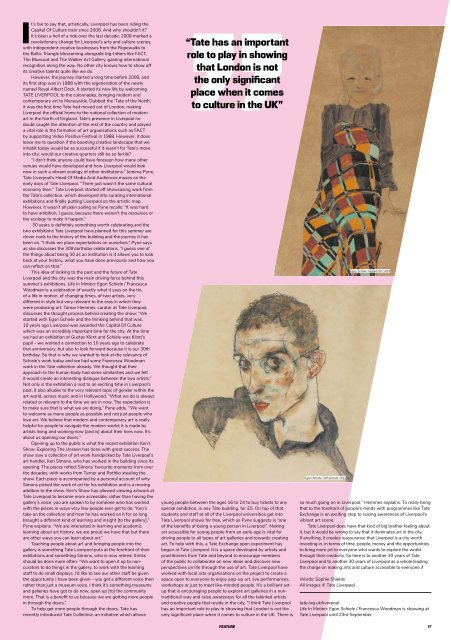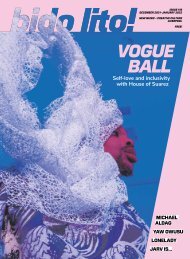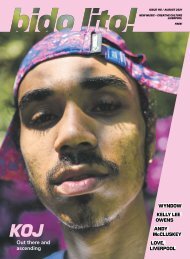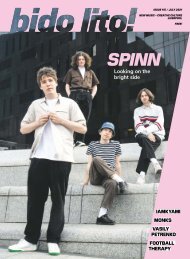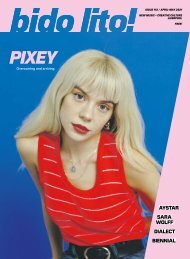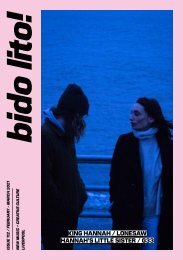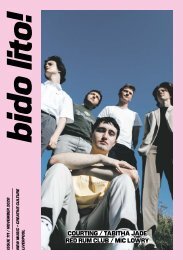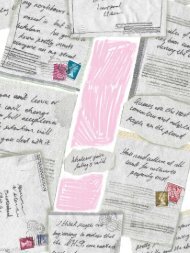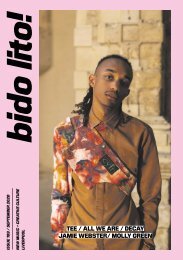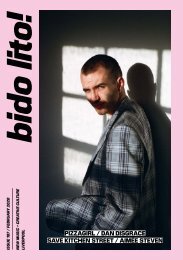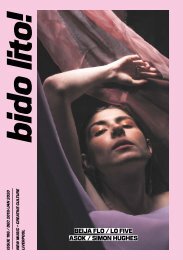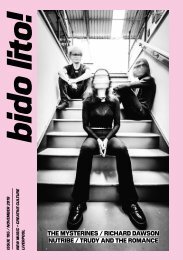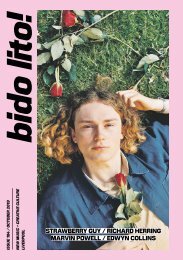Issue 90 / July 2018
July 2018 issue of Bido Lito! magazine. Featuring: MC NELSON, THE DSM IV, GRIME OF THE EARTH, EMEL MATHLOUTHI, REMY JUDE, LIVERPOOL BIENNIAL, CAR SEAT HEADREST, THE MYSTERINES, TATE @ 30 and much more.
July 2018 issue of Bido Lito! magazine. Featuring: MC NELSON, THE DSM IV, GRIME OF THE EARTH, EMEL MATHLOUTHI, REMY JUDE, LIVERPOOL BIENNIAL, CAR SEAT HEADREST, THE MYSTERINES, TATE @ 30 and much more.
Create successful ePaper yourself
Turn your PDF publications into a flip-book with our unique Google optimized e-Paper software.
It’s fair to say that, artistically, Liverpool has been riding the<br />
Capital Of Culture train since 2008. And why shouldn’t it?<br />
It’s been a hell of a ride over the last decade: 2008 marked a<br />
revolutionary change for Liverpool’s arts and culture scenes,<br />
with independent creative businesses from the Ropewalks to<br />
the Baltic Triangle blossoming alongside big-hitters like FACT,<br />
The Bluecoat and The Walker Art Gallery, gaining international<br />
recognition along the way. No other city knows how to show off<br />
its creative talents quite like we do.<br />
However, the journey started a long time before 2008, and<br />
its first stop was in 1988 with the regeneration of the newly<br />
named Royal Albert Dock. It started its new life by welcoming<br />
TATE LIVERPOOL to the colonnades, bringing modern and<br />
contemporary art to Merseyside. Dubbed the ‘Tate of the North’,<br />
it was the first time Tate had moved out of London, making<br />
Liverpool the official home to the national collection of modern<br />
art in the North of England. Tate’s presence in Liverpool no<br />
doubt caught the attention of the rest of the country and played<br />
a vital role in the formation of art organisations such as FACT<br />
by supporting Video Positive Festival in 1988. However, it does<br />
leave me to question if the booming creative landscape that we<br />
inhabit today would be so successful if it wasn’t for Tate’s move<br />
into city; would our creative quarters still be so fertile?<br />
“I don’t think anyone could have foreseen how many other<br />
venues would have developed and how Liverpool would look<br />
now in such a vibrant ecology of other institutions,” Jemima Pyne,<br />
Tate Liverpool’s Head Of Media And Audiences muses on the<br />
early days of Tate Liverpool. “There just wasn’t the same cultural<br />
economy then.” Tate Liverpool started off showcasing work from<br />
the Tate’s collection, which developed into curating international<br />
exhibitions and finally putting Liverpool on the artistic map.<br />
However, it wasn’t all plain sailing as Pyne recalls: “It was hard<br />
to have ambition, I guess, because there weren’t the resources or<br />
the ecology to make it happen.”<br />
30 years is definitely something worth celebrating and the<br />
two exhibitions Tate Liverpool have planned for this summer are<br />
clever nods to the history of the building and the journey it has<br />
been on. “I think we place expectations on ourselves,” Pyne says<br />
as she discusses the 30th birthday celebrations. “I guess one of<br />
the things about being 30 as an institution is it allows you to look<br />
back at your history, what you have done previously and how you<br />
can reflect on that.”<br />
This idea of looking to the past and the future of Tate<br />
Liverpool and the city was the main driving force behind this<br />
summer’s exhibitions. Life In Motion: Egon Schiele / Francesca<br />
Woodman is a celebration of exactly what it says on the tin,<br />
of a life in motion, of changing times, of two artists, very<br />
different in style but very relevant to the eras in which they<br />
were producing art. Tamar Hemmes, curator at Tate Liverpool,<br />
discusses the thought process behind creating the show: “We<br />
started with Egon Schiele and the thinking behind that was,<br />
10 years ago Liverpool was awarded the Capital Of Culture<br />
which was an incredibly important time for the city. At the time<br />
we had an exhibition of Gustav Klimt and Schiele was Klimt’s<br />
pupil – we wanted a connection to 10 years ago to celebrate<br />
that anniversary, but also to look forward because it is our 30th<br />
birthday. So that is why we wanted to look at the relevance of<br />
Schiele’s work today and we had some Francesca Woodman<br />
work in the Tate collection already. We thought that their<br />
approach to the human body had some similarities and we felt<br />
it would create an interesting dialogue between the two artists.”<br />
Not only is the exhibition a nod to an exciting time in Liverpool’s<br />
past, it also alludes to the very relevant topic of gender within the<br />
art world, across music and in Hollywood. “What we do is always<br />
related or relevant to the time we are in now. The expectation is<br />
to make sure that is what we are doing,” Pyne adds. “We want<br />
to welcome as many people as possible and not just people who<br />
love art. We believe that modern and contemporary art is really<br />
helpful for people to navigate the modern world; it is made by<br />
artists living and working now [and is] about their lives now. It’s<br />
about us opening our doors.”<br />
Opening up to the public is what the recent exhibition Ken’s<br />
Show: Exploring The Unseen has done with great success. The<br />
show saw a collection of art work handpicked by Tate Liverpool’s<br />
art handler, Ken Simons, who has worked in the building since its<br />
opening. The pieces reflect Simons’ favourite moments from over<br />
the decades, with works from Turner and Rothko stealing the<br />
show. Each piece is accompanied by a personal account of why<br />
Simons picked the work of art for his exhibition and is a moving<br />
addition to the show. Ken’s Show has allowed viewing artwork at<br />
Tate Liverpool to become more accessible; rather than having the<br />
gallery’s voice, you are spoken to by someone who has worked<br />
with the pieces in ways very few people ever get to do. “Ken’s<br />
take on the collection and how he has worked on it for so long<br />
brought a different kind of learning and insight [to the gallery],”<br />
Pyne explains. “We are interested in learning and academic<br />
learning about art history, we are proud we have that but there<br />
are other ways you can learn about art.”<br />
Teaching people about art and bringing people into the<br />
gallery is something Tate Liverpool puts at the forefront of their<br />
exhibitions and something Simons, who is now retired, thinks<br />
should be done more often: “We want to open it up to noncurators<br />
to do things in the gallery, to work with the learning<br />
staff to do small displays. I’d like to see our other staff be given<br />
the opportunity I have been given – you get a different voice then<br />
rather than just a museum voice. I think it’s something museums<br />
and galleries have got to do now, open up [to] the community<br />
more. That is a benefit to us because we are getting more people<br />
in through the doors.”<br />
To help get more people through the doors, Tate has<br />
recently introduced Tate Collective, an initiative which allows<br />
“Tate has an important<br />
role to play in showing<br />
that London is not<br />
the only significant<br />
place when it comes<br />
to culture in the UK”<br />
young people between the ages 16 to 24 to buy tickets to any<br />
special exhibition, in any Tate building, for £5. On top of that,<br />
students and staff at all of the Liverpool universities get into<br />
Tate Liverpool shows for free, which as Pyne suggests is “one<br />
of the benefits of being a young person in Liverpool”. Making<br />
art accessible for young people from an early age is vital for<br />
driving people to all types of art galleries and towards creating<br />
art. To help with this, a Tate Exchange open experiment has<br />
begun at Tate Liverpool. It is a space developed by artists and<br />
practitioners from Tate and beyond to encourage members<br />
of the public to collaborate on new ideas and discover new<br />
perspectives on life through the use of art. Tate Liverpool have<br />
worked with local arts organisations on the project to create a<br />
space open to everyone to enjoy pop-up art, live performances,<br />
workshops or just to meet like-minded people. It’s a brilliant setup<br />
that is encouraging people to explore art galleries in a nontraditional<br />
way and raise awareness for all the talented artists<br />
and creative people that reside in the city. “I think Tate Liverpool<br />
has an important role to play in showing that London is not the<br />
only significant place when it comes to culture in the UK. There is<br />
Egon Schiele, Self portrait 1914<br />
so much going on in Liverpool,” Hemmes explains. To really bring<br />
that to the forefront of people’s minds with programmes like Tate<br />
Exchange is an exciting step to raising awareness of Liverpool’s<br />
vibrant art scene.<br />
Tate Liverpool does have that kind of big brother feeling about<br />
it, but it would be wrong to say that it dominates art in the city.<br />
If anything, it creates reassurance that Liverpool is a city worth<br />
investing in, in terms of time, people, money and the opportunities<br />
to bring more art to everyone who wants to explore the world<br />
through their creativity. So here is to another 30 years of Tate<br />
Liverpool and to another 30 years of Liverpool as a whole leading<br />
the charge on making arts and culture accessible to everyone. !<br />
Words: Sophie Shields<br />
All images © Tate Liverpool<br />
Egon Schiele, Seated Girl 1910<br />
tate.org.uk/liverpool<br />
Life In Motion: Egon Schiele / Francesca Woodman is showing at<br />
Tate Liverpool until 23rd September.<br />
FEATURE<br />
17


